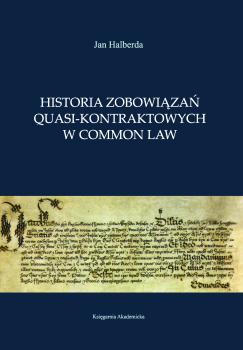Historia zobowiązań quasi-kontraktowych w Common Law
Słowa kluczowe:
zobowiązania quasi-kontraktowe, common lawStreszczenie
The book is an upgraded version of the doctoral dissertation, which was awarded the first prize in the XLIV National Competition "State and Law" (XLIV Ogólnopolski Konkurs „Państwa i Prawa") for the best habilitation and doctoral dissertations in the field of legal sciences (2009). The book deals with the evolution of the law of unjust enrichment in England. The book is concerned with the forms of action based on implied promises that in old England were called quasi-contracts. They were not identical with the Roman quasi-contarcts. Such actions developed into a law of unjust enrichment in the late 20th century. The book is divided into two parts. The first presents the common law environment in which the implied contracts were evolving: the sources of law (1), the system of courts (2), the concept of procedural writs (forms of actions) (3) and the course of court proceedings (4). The second part presents the history of quasi-contracts. It begins with the medieval contract law (5), then deals with the development of writ of assumpsit (6) and procedural formula of indebitatus assumpsit (7). Next chapter (8) discusses Lord Mansfield’s decision in Moses v. MacFerlan (1760) that was critical for the subsequent development of the law of unjust enrichment (8). The longest chapter presents the 19th century case law on specific quasi-contracts, that evolved later into the unjust factors on the basis of which the modern law of unjust enrich-ment was founded (9). In the final part, the book presents the law of unjust enrichment that emerged at the end of the 20th centuries, discussing such leading cases as Lipkin Gorman v. Karpnale Ltd (1991) and Woolwich Equitable Building Society v. IRC (1993).
Rozdziały
-
TABLE OF CONTENTS
-
Wprowadzenie .......... 9
-
ROZDZIAŁ I. ŹRÓDŁA PRAWA
-
1. Źródła powstania prawa .......... 37
-
2. Źródła poznania prawa .......... 56
-
ROZDZIAŁ II. SĄDOWNICTWO
-
1. Wprowadzenie .......... 63
-
2. Sądownictwo w średniowieczu .......... 64
-
3. Sądownictwo w czasach nowożytnych .......... 83
-
4. Reformy sądownictwa w XIX w .......... 89
-
ROZDZIAŁ III. RYTY PROCESOWE
-
1. Znaczenie instytucji .......... 93
-
2. Systematyka rytów .......... 95
-
3. Nominalizm rytów .......... 102
-
4. Odrębność postępowań – forms of action .......... 105
-
5. Skutki wyboru niewłaściwego rytu .......... 107
-
6. Koniec świata rytów? .......... 108
-
ROZDZIAŁ IV. POSTĘPOWANIE SĄDOWE .......... 111
-
1. Pierwsze kroki .......... 111
-
2. Stawiennictwo pozwanego (mesne process) .......... 112
-
3. Wymiana argumentów (pleading) .......... 116
-
4. Poznanie prawdy w procesie .......... 122
-
5. Wyrok .......... 134
-
6. Środki odwoławcze .......... 141
-
7. Postępowanie egzekucyjne (final process) .......... 145
-
ROZDZIAŁ V. PRAWO UMÓW W ŚREDNIOWIECZU
-
1. Nominalizm kontraktowy .......... 147
-
2. Starsze ryty osobowe .......... 149
-
3. Ochrona umów w konkurencyjnych systemach sądownictwa .......... 157
-
4. Rozwój rytu w sprawie. Rozszerzenie odpowiedzialności kontraktowej .......... 161
-
5. Rozwój rytu o rachunek. Rozszerzenie odpowiedzialności quasi-kontraktowej .......... 178
-
ROZDZIAŁ VI. POCZĄTKI NOWEGO PRAWA UMÓW – RYT PROMISYJNY (ASSUMPSIT) W XVI W. I NA POCZĄTKU XVII W
-
1. Kierunki rozwoju rytu promisyjnego .......... 183
-
2. Zastosowanie rytu promisyjnego do umów konsensualnych. Doktryna consideration .......... 185
-
3. Zastosowanie rytu promisyjnego zamiast rytu o dług .......... 195
-
4. Proces Slade v. Morley (1602) .......... 205
-
ROZDZIAŁ VII. POWSTAWANIE PRAWA QUASI-KONTRAKTÓW – RYT INDEBITATUS ASSUMPSIT OD XVII W. DO POŁOWY XVIII W.
-
1. Wprowadzenie .......... 215
-
2. Odmiany rytu promisyjnego .......... 216
-
3. Formuły quantum meruit i quantum valebat .......... 224
-
4. Zastępowanie rytu o dług w wypadkach niekontraktowych .......... 236
-
5. Zastępowanie rytu o rachunek .......... 243
-
6. Dalsza ekspansja formuł quasi-kontraktowych .......... 250
-
ROZDZIAŁ VIII. PROCES MOSES V. MACFERLAN (1760) – W POSZUKIWANIU UZASADNIENIA DLA QUASI-KONTRAKTÓW
-
1. Wprowadzenie. Brak spójnej koncepcji .......... 271
-
2. Stan faktyczny i tok postępowania w Moses v. MacFerlan .......... 274
-
3. Poglądy lorda Mansfielda na temat bezpodstawnego wzbogacenia .......... 276
-
4. Krytyka wyroku Moses v. MacFerlan .......... 282
-
5. Blackstone na temat quasi-kontraktów .......... 287
-
ROZDZIAŁ IX. QUASI-KONTRAKTY NA PRZESTRZENI XIX W. – ZOBOWIĄZANIA WYNIKAJĄCE Z DOROZUMIANEGO KONTRAKTU
-
1. Koncepcja kontraktów dorozumianych (implied contract theory) .......... 291
-
2. Błąd .......... 296
-
3. Przymus .......... 311
-
4. Przymusowa zapłata cudzego długu .......... 321
-
5. Upadek przyczyny, dla której spełniono świadczenie .......... 335
-
6. Sprzeczność umowy z prawem .......... 353
-
7. Formuła quantum meruit .......... 363
-
8. Zrzeczenie się deliktu (waiver of tort) .......... 371
-
9. Zarzuty .......... 377
Downloads
Bibliografia





